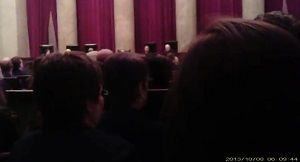Protestor Sneaks Video Peak At Supremes Oral Argument

A protester in the gallery managed to sneak a recording device into Supreme court oral argument, producing what is believed to be the first video from a Supreme Court oral argument (http://www.youtube.com/watch?v=2K-8FJ114kU), prompting C-SPAN to renew its offer to provide unedited, gavel-to-gavel professional coverage of the court.
The video was brief and of poor quality, similar to the surreptitious home movies of some Broadway shows of the last century, which in some cases was the only film record of them.
A court spokesperson had not returned a call for comment at press time on the taping or what security measures the court might tighten--checking everybody's glasses to make sure they can't "Google" with them, for instance.
No cameras or any recording devices are allowed in the court, unlike many lower courts, and House and Senate proceedings, the latter thanks to C-SPAN, which has been pushing the court for years to allow its professional recording equipment to widen the courts' public gallery to the nation.
The video posted on YouTube began with the advisory that "Under their arcane rules, no one is allowed to record the proceedings...Not even C-SPAN in the year 2014." The oral argument being heard was McCutcheon v. FEC," and the video was identified as being associated with a group protesting the related Citizen's United Supreme Court decision. It eventually shows the protestor rising to speak briefly before being forcibly removed from the gallery.
"We’re living in a video age. People now expect to have video of everything in their private lives," said Bruce Collins, VP and general counsel of C-SPAN. "They expect every news story to have at least a video clip. For a segment of the public, if there is no video of it, a thing must not be important or must not even exist.
"So, in a sense it is no surprise that someone would eventually sneak a video camera into the Supreme Court. This fellow obviously thinks the Court is important and that therefore it should be as accessible to him as the Congress, the President and almost every other public forum is."
Multichannel Newsletter
The smarter way to stay on top of the multichannel video marketplace. Sign up below.
"It is a shame that this is how a Supreme Court oral argument would first appear on television – a jumbled, awkward YouTube video."
Collins renewed C-SPAN's offer to do for the court what it has done for the legislative process, which is to let the people see the workings of the people's House--and Senate.
"We think the justices should accept the reality of this video age and give the people what they want – let the TV journalists in the courtroom," said Collins. "C-SPAN’s offer to the Chief Justice stands: if the Court decides to televise its oral arguments, we will be happy to provide gavel to gavel coverage of every argument, and put everyone of them on television without any editing or commentary.
Kathy Arberg, public information officer for the court, said it was the first ever videotaping of the court that they knew of. "The Court is in the process of reviewing the video and our courtroom screening procedures," she said.
Contributing editor John Eggerton has been an editor and/or writer on media regulation, legislation and policy for over four decades, including covering the FCC, FTC, Congress, the major media trade associations, and the federal courts. In addition to Multichannel News and Broadcasting + Cable, his work has appeared in Radio World, TV Technology, TV Fax, This Week in Consumer Electronics, Variety and the Encyclopedia Britannica.










